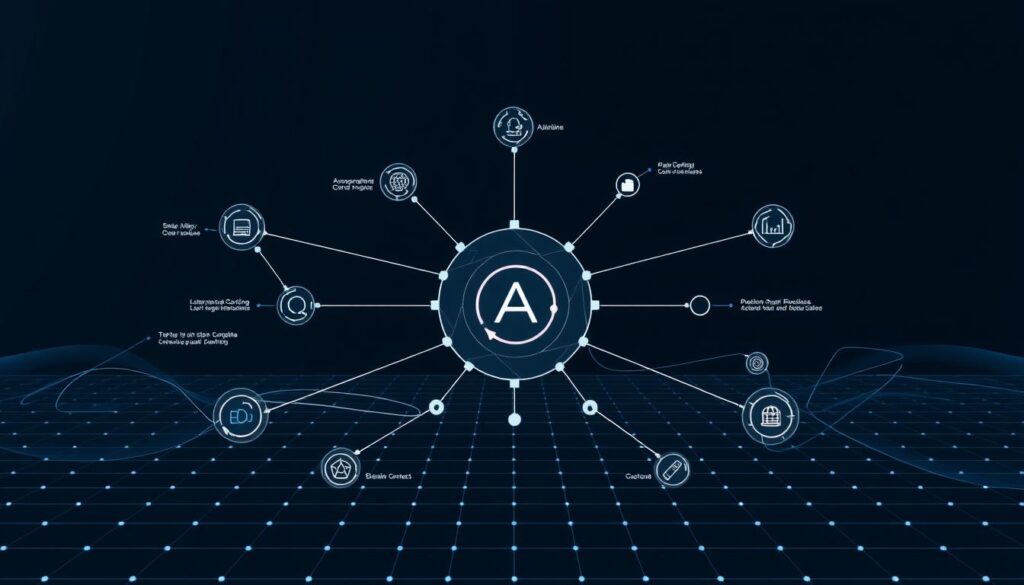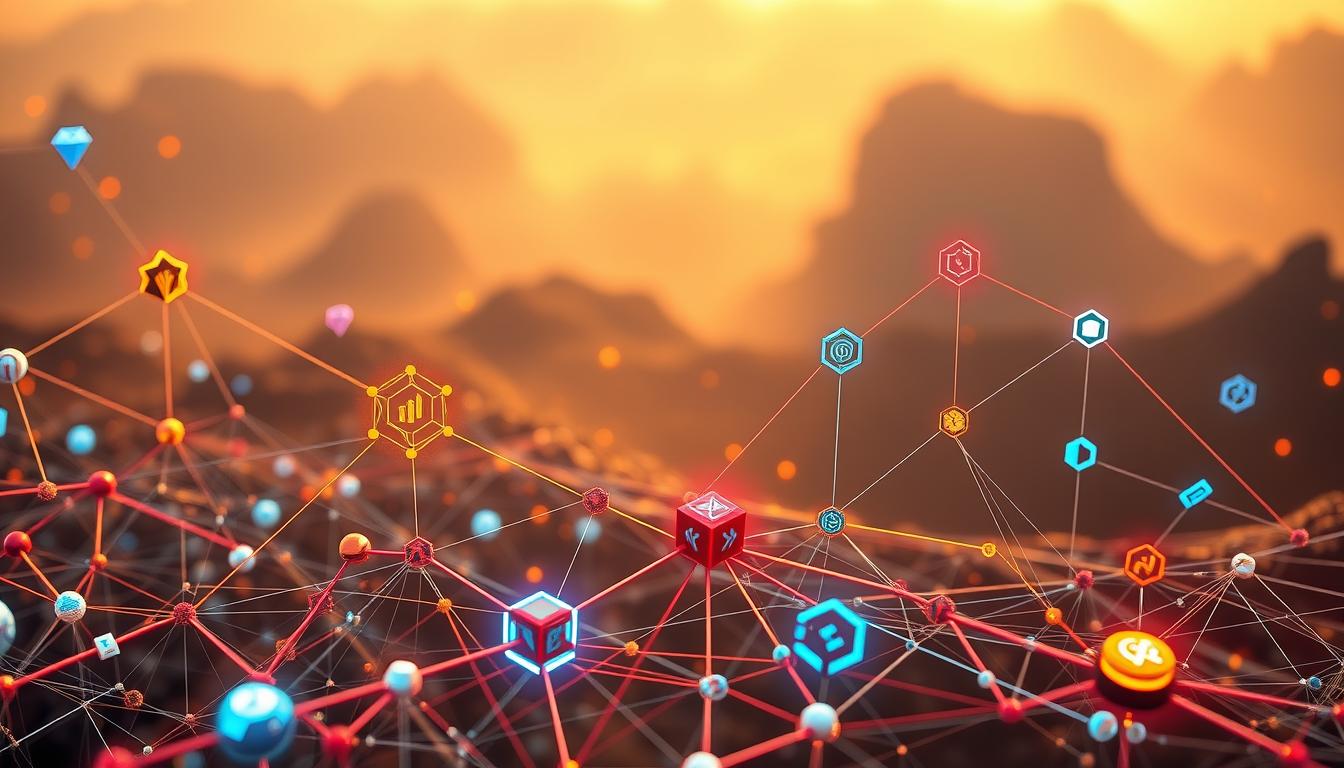Now Reading: Unlocking Insights with Artificial intelligence blockchain data analysis Techniques
- 01
Unlocking Insights with Artificial intelligence blockchain data analysis Techniques
Unlocking Insights with Artificial intelligence blockchain data analysis Techniques

Modern organizations face a constant challenge. They need to make smart choices quickly. Powerful new tools are changing how we handle information. These systems help us see patterns we might otherwise miss.
This guide explores a powerful combination of technologies. It shows how to turn complex information into clear, useful insights. The goal is to help businesses improve their operations and security.
We will look at practical methods for putting these ideas to work. From basic concepts to advanced applications, you will learn how to achieve real results. This approach delivers value across many fields, from finance to healthcare.
This content is for leaders and technical experts alike. It provides a clear path for using these modern tools to gain a competitive edge. You will finish with a solid understanding of how to implement these solutions successfully.
Key Takeaways
- Learn how advanced technologies transform complex information into actionable insights.
- Discover methods to enhance security and streamline business operations.
- Gain practical knowledge for implementing these techniques from start to finish.
- Understand the strategic value this combination brings to various industries.
- Explore real-world examples that demonstrate measurable success.
- Identify the tools and considerations needed for a successful deployment.
Introduction to the Convergence of AI and Blockchain Data Analysis
A new era of technological synergy is emerging that combines computational intelligence with decentralized trust systems. This powerful combination creates opportunities for more secure and insightful information processing.
Understanding the Foundations of Artificial Intelligence
Artificial intelligence represents computer systems designed to mimic human cognitive functions. These systems use sophisticated algorithms to process information and make decisions.
Machine learning and deep learning are key sub-fields within this domain. They train on information sets to generate accurate predictions and classifications.
The technology continuously improves its performance through exposure to larger datasets. This makes it ideal for handling complex structures found in modern digital environments.
Exploring the Basics of Blockchain Networks
Blockchain technology functions as a shared, immutable ledger that provides transparent exchange of encrypted information. Multiple parties can access this data simultaneously during transactions.
These distributed systems track various business processes including orders, payments, and accounts. Permissioned members maintain confidence through tamper-proof record-keeping.
The convergence of these foundational technologies creates unprecedented opportunities. Organizations can extract valuable insights from decentralized sources that were previously difficult to analyze effectively.
The Evolution of Blockchain and AI Technologies
Two revolutionary technological domains have matured alongside each other, transforming from academic concepts to enterprise solutions. Their parallel development has created powerful synergies that are reshaping how organizations process information.
Historical Perspectives and Milestones
The journey began with separate foundations. Distributed ledger systems emerged from cryptographic research in the 1990s. Meanwhile, machine learning evolved from early expert systems into sophisticated neural networks.
Key breakthroughs occurred around 2008-2015. Smart contracts and enterprise platforms like Hyperledger Fabric expanded blockchain applications beyond cryptocurrency. Deep learning advancements enabled more accurate pattern recognition capabilities.

Modern Integrations and Innovations
Today’s integrations demonstrate remarkable maturity. Organizations deploy cognitive systems to analyze distributed ledger information. This combination delivers measurable value across multiple sectors.
Current applications include fraud detection, supply chain optimization, and automated compliance. The market for these combined solutions shows exponential growth projections near 90% CAGR.
| Year | Blockchain Development | AI Advancement | Combined Impact |
|---|---|---|---|
| 2008 | Bitcoin whitepaper | Deep learning resurgence | Foundation for decentralized systems |
| 2015 | Ethereum smart contracts | TensorFlow release | Programmable blockchain capabilities |
| 2017 | Enterprise blockchain platforms | Transformer architecture | Industrial-scale applications |
| 2020-Present | Cross-chain interoperability | Specialized blockchain analytics | Integrated business intelligence |
Key Benefits and Use Cases Across Industries
Real-world applications demonstrate how this technological combination transforms traditional business processes. Organizations across multiple sectors achieve competitive advantages through improved decision-making and operational efficiency.
Transformative Impacts in Healthcare and Financial Services
In healthcare, these systems surface treatment insights from patient records. Electronic health records on distributed ledgers enable collaborative care while protecting privacy.
The pharmaceutical sector gains enhanced visibility in drug supply chains. Clinical trial success rates improve dramatically with better information integrity.
Financial services experience reduced friction in multiparty transactions. Loan processes accelerate through automated evaluation of verified personal records.
| Industry | Primary Benefit | Key Application | Measurable Outcome |
|---|---|---|---|
| Healthcare | Collaborative care improvement | Electronic health records management | Enhanced patient privacy protection |
| Financial Services | Transaction acceleration | Automated loan processing | Faster customer satisfaction |
| Pharmaceutical | Supply chain visibility | Clinical trial optimization | Increased success rates |
| Logistics | Process digitization | Compliance verification | Resource optimization |

Real-World Examples in Supply Chain and Beyond
Supply chain applications digitize paper-based processes. They create shareable, trustworthy information with automated transaction execution.
Businesses optimize logistics and verify compliance through these integrated systems. IPwe’s Global Patent Registry manages intellectual property with increased flexibility.
IBM Food Trust combines distributed ledger technology with cognitive computing for farm-level decisions. These use cases deliver reduced operational risks across diverse industries.
Leveraging Artificial Intelligence Blockchain Data Analysis for Business Intelligence
Forward-thinking enterprises are now unlocking a powerful synergy between advanced computational systems and distributed ledger technologies. This combination turns complex ledger entries into clear, strategic knowledge.
It drives smarter choices and improves how companies operate. The goal is to gain a real competitive edge.

How AI Enhances Data Interpretation on Blockchains
Smart software can read and understand on-chain information at incredible speeds. It finds patterns and connections that manual reviews would miss.
This brings a new level of understanding to business networks. Organizations get real-time insights for immediate action.
Distributed ledgers provide access to vast amounts of verified information. This helps cognitive systems scale effectively.
Each technology makes the other more capable. The result is more reliable and useful knowledge.
The systematic examination of on-chain records is crucial. It reveals network activity, user behavior, and transaction flows.
This process informs strategic decisions with solid evidence. Specialized tools filter and visualize complex datasets.
| Analysis Focus | Key Metric Examples | Business Impact |
|---|---|---|
| Transaction Patterns | Frequency, size, participant clusters | Fraud detection, market trend identification |
| Protocol Health | Total value locked, validator performance | Network reliability assessment, investment decisions |
| Smart Contract Interactions | Execution success rates, gas usage | Operational efficiency, cost optimization |
Companies use these methodologies to manage risk and optimize performance. The transparency offered is unmatched by traditional systems.
This leads to proactive management and informed financial strategies. Continuous monitoring ensures peak operational effectiveness.
Enhancing Security with Machine Learning and Blockchain
Security concerns in digital systems require innovative approaches that combine multiple technological layers. The integration of adaptive algorithms with distributed ledgers creates powerful protection mechanisms.

This combination addresses critical vulnerabilities in modern digital infrastructure. It provides both proactive threat detection and transparent audit trails.
Fraud Detection and Anomaly Identification
Machine learning algorithms excel at spotting unusual patterns across vast networks. They process thousands of transactions per second to identify potential threats.
These systems screen activities against known risk indicators and sanction lists. They help organizations meet compliance requirements while preventing financial crimes.
The immutable nature of distributed ledgers provides perfect training information for security models. This creates a virtuous cycle of improving detection accuracy.
Smart Contract Optimization and Risk Management
Self-executing agreements benefit significantly from computational oversight. Intelligent systems can analyze code for potential vulnerabilities before deployment.
They simulate various execution scenarios to identify failure points. Continuous monitoring ensures contracts perform as intended without costly errors.
This automation reduces operational risks while maintaining transaction integrity. Organizations gain confidence in their automated agreement systems.
- Real-time behavior monitoring flags suspicious activities instantly
- Pattern recognition identifies emerging threat vectors
- Code analysis prevents vulnerabilities in automated agreements
- Comprehensive audit trails support regulatory compliance
Utilizing AI for Supply Chain Transparency and Efficiency
The marriage of cognitive computing and immutable record-keeping is revolutionizing how goods move from production to consumption. This powerful combination addresses long-standing challenges in global logistics networks.
Companies gain unprecedented visibility into their operations. They can track items at every stage with confidence in the information’s accuracy.
Monitoring and Verifying Logistics Data
Smart systems continuously examine shipment records on distributed ledgers. They identify patterns and potential issues in real time.
Temperature controls, handling procedures, and delivery timelines get automatic verification. This reduces manual oversight while improving reliability.
Manufacturers can track carbon emissions at the product level with new precision. IBM Food Trust demonstrates this approach in agriculture, combining ledger technology with decision platforms.
The result is smarter routing, faster problem detection, and better compliance. Organizations achieve measurable improvements in operational performance and customer trust.
Data Analysis Tools and Techniques in Blockchain Environments
Navigating the vast landscape of on-chain records requires purpose-built analytical solutions. Traditional business intelligence tools struggle with the volume and complexity of distributed ledger information.
Specialized platforms have emerged to address distinct organizational needs. They range from compliance-focused systems to market intelligence and custom research applications.
Overview of Leading Blockchain Analytics Platforms
Chainalysis leads in compliance solutions for financial institutions. It offers AML/KYC capabilities and investigation software for regulatory requirements.
Dune Analytics provides flexible SQL-based querying across multiple chains. Users can build custom dashboards for bespoke research projects.
Messari delivers professional-grade market intelligence for institutional investors. The platform offers comprehensive research reports and screening tools.
| Platform | Primary Focus | Key Capabilities | Target Users |
|---|---|---|---|
| Chainalysis | Compliance & Risk | AML/KYC, Investigation | Financial Institutions |
| Dune Analytics | Custom Research | SQL Queries, Dashboards | Researchers & Analysts |
| Messari | Market Intelligence | Research Reports, APIs | Institutional Investors |
| TRM Labs | End-to-End Compliance | Transaction Monitoring | Crypto Businesses |
| Nansen AI | Smart Money Tracking | Wallet Labeling, NFT Analysis | Traders & Funds |
Additional solutions like TRM Labs and Elliptic focus on cryptoasset risk management. Technical platforms such as Coinpath specialize in transaction path tracing.
For advanced predictive analytics using blockchain data, platforms like AnChain.AI utilize machine learning for security intelligence. The right platform choice depends on specific compliance needs and technical capabilities.
Advanced Machine Learning Applications in Blockchain Data Analysis
Sophisticated algorithms are now taking distributed ledger analytics far beyond simple reporting. These advanced systems deliver proactive insights and automated actions.
This evolution marks a significant leap in capability. Companies gain a powerful strategic advantage.
Predictive Analytics and Market Trends
Machine learning models excel at forecasting future events. They examine vast historical information to spot subtle patterns.
In decentralized finance, these tools help traders identify optimal entry and exit points. They can forecast price movements with impressive accuracy.
Sentiment analysis technologies monitor news and social media. This provides early warnings about potential market swings.
Real-Time Monitoring and Automated Decision-Making
Smart contracts powered by these models operate autonomously. They can execute transactions like reorders or payments based on preset rules.
This automation eliminates human error and emotional bias. It ensures consistent application of business logic across thousands of operations.
Real-time systems can also recommend product recalls or select sustainable shipping methods. The benefits include faster response times and continuous network monitoring.
| Application Area | Core Function | Business Outcome |
|---|---|---|
| Market Forecasting | Price movement prediction | Optimized trading strategies |
| Fraud Prevention | Anomaly detection | Reduced financial risk |
| Supply Chain | Automated transaction execution | Improved operational efficiency |
| Compliance | Continuous monitoring | Enhanced regulatory adherence |
Overcoming Challenges in Integrating Blockchain and AI Solutions
Successfully combining these systems demands overcoming several critical barriers. Organizations must navigate complex technical and regulatory landscapes.
Teams encounter significant infrastructure demands. Processing requirements can strain existing systems.
Scalability remains a persistent concern for growing networks.
Addressing Data Privacy and Regulatory Concerns
Privacy protection creates tension between transparency needs and information access. Regulations like GDPR require careful compliance strategies.
Advanced privacy technologies complicate analytical approaches. Organizations must balance insight generation with legal requirements.
Managing Infrastructure and Scalability Issues
Substantial investments in specialized databases and expertise impact project budgets. Popular networks generate massive information volumes.
Efficient storage and querying solutions become essential for performance.
| Challenge Type | Specific Issues | Impact Level | Mitigation Approaches |
|---|---|---|---|
| Computational Demands | High processing power requirements | High | Cloud infrastructure, optimized algorithms |
| Scalability Limitations | Network transaction volume constraints | Medium-High | Layer 2 solutions, sharding techniques |
| Privacy Compliance | GDPR, CCPA regulatory alignment | High | Privacy-preserving analytics, careful architecture |
| Infrastructure Costs | Specialized database investments | Medium | Phased implementation, partnership strategies |
| Regulatory Uncertainty | Evolving global standards | Medium | Compliance-focused design, legal consultation |
Strategic partnerships with experienced consultants help navigate these obstacles. Phased implementation proves value incrementally while managing risk.
Privacy-preserving techniques balance insight generation with information protection. These approaches enable successful deployment despite the challenges.
Future Trends and Innovations in AI-Driven Blockchain Analysis
Next-generation capabilities in distributed network scrutiny will redefine how enterprises extract strategic value. The field continues to evolve with exciting developments on the horizon.
Organizations can expect more sophisticated pattern recognition and anomaly detection. These advancements will significantly enhance current capabilities.
Emerging Use Cases and Technological Advancements
Self-governing organizations powered by computational systems represent a major innovation. These entities operate efficiently without centralized management.
Privacy-preserving approaches allow collaborative model training across boundaries. Organizations maintain confidentiality while gaining collective insights.
Advanced cryptographic methods address emerging quantum computing threats. This ensures network security against future technological challenges.
Cross-Chain Analytics and Next-Generation AI Integrations
Intelligent models will examine multiple distributed networks simultaneously. This provides unified visibility across the expanding ecosystem.
Self-learning agreements adapt to changing market conditions automatically. They optimize execution based on historical performance patterns.
These integrations create more intelligent and adaptive systems. The result is enhanced security and strategic advantage across industries.
Conclusion
The strategic fusion of cognitive computing and distributed ledger technology marks a pivotal moment for modern enterprises. This guide has detailed how this combination transforms complex information into a clear competitive edge.
Companies that adopt these powerful solutions gain deeper insights and enhance security. They achieve measurable outcomes like proactive risk management and superior operational efficiency.
Mastering this form of analysis is becoming a core business competency. As more organizations explore blockchain use cases, the demand for specialized expertise will surge.
Despite implementation challenges, the strategic value is immense. By applying the frameworks discussed, businesses can confidently turn decentralized data into tangible success.
FAQ
How do machine learning capabilities improve supply chain management?
Machine learning algorithms analyze logistics information to predict delays, optimize routes, and verify the authenticity of goods. This boosts operational efficiency and provides greater visibility across the entire chain.
What role does this technology play in protecting patient records?
Combining these systems enhances data security and integrity for sensitive healthcare information. Smart contracts can manage access permissions, ensuring privacy while allowing authorized analysis for medical insights.
Can these solutions help with financial services compliance?
Yes, they offer powerful tools for monitoring transactions. Automation helps identify suspicious patterns, ensuring regulatory compliance and reducing risk for organizations in the financial market.
What are the primary benefits for businesses adopting these innovations?
Companies gain enhanced transparency, improved operational efficiency, and stronger security protocols. These advantages help organizations build trust and gain a competitive edge in their industries.
How is information integrity maintained on these platforms?
The decentralized nature of the networks, combined with advanced cryptographic techniques, creates an immutable ledger. This ensures that records cannot be altered, providing a trustworthy foundation for analysis.















